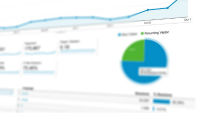Written By Kyle O.
Google Analytics provides an amazing amount of insight for business owners interested in who their website audience is. On the basic level, Google Analytics is a free service, although there is an enterprise version with more advanced features. In this week’s blog, we’ll talk about the types of data you receive from Google Analytics, and the ways that you can use that data to set goals and target your messaging toward the right visitors. Data analysis is a key part of your digital marketing strategy, and many businesses make the choice to enlist a digital marketing team to help them along the journey. We hope that you’ll enjoy this introduction to Google Analytics and start to make the most of this valuable information as you move forward with your digital strategy.
There are four main ways that Google Analytics groups data: Audience, Acquisition, Behavior and Conversions.
Audience
Audience, as you may guess, includes information about how many visitors you have and who they are. This includes info about:
- Demographics (age and gender)
- Interests (baseball, online shopping, etc.)
- Location (both national and international visitors)
- Language
- Technology (mobile, desktop or tablet breakdown as well as what browsers they use online)
In addition to this background information, you’ll also be able to see how many new users you have versus returning users. You can begin to identify which users frequent your site and what type of people they are.
Acquisition
The way you acquire users can show you what tactics are working to deliver potential customers to your site and which aren’t. When you look at acquisition data, you can see a wealth of information about  where your users came from on the internet. This means you can see if they came directly to your site by typing in your website, if they were directed to your site from a social media post, if they came from a link in an email you sent, if they were directed from an ad you placed online, and more. Acquisition allows you to drill down even further into each of these acquisition channels to see which draw repeat visitors and what types of audiences come from each channel. If a digital ad isn’t working, but social media is, you can consider adjusting your advertising spend in the most lucrative channels and stop wasting time on those that may not deliver results.
where your users came from on the internet. This means you can see if they came directly to your site by typing in your website, if they were directed to your site from a social media post, if they came from a link in an email you sent, if they were directed from an ad you placed online, and more. Acquisition allows you to drill down even further into each of these acquisition channels to see which draw repeat visitors and what types of audiences come from each channel. If a digital ad isn’t working, but social media is, you can consider adjusting your advertising spend in the most lucrative channels and stop wasting time on those that may not deliver results.
Behavior
Behavior analytics show you how visitors use your website. It will show you which pages are most popular among visitors, which pages visitors most frequently enter your website, which they most frequently leave from, and even the path they take from page to page on your site. You can see which pages visitors stay on for a longer period (which may be a sign the content there is most engaging) and which they leave from quickly. You can compare behavior data with acquisition data to see which visitors spend quality time on your site and where those visitors came from. Once you understand the path your visitors come from and the journey they take on your website, you can begin to adjust your content accordingly to drive them toward an end goal, which brings us to conversions.
Conversions
Conversions are the number of visitors who achieve a specific goal or goals that you’ve identified on Google Analytics. You or a web developer will need to enter a specific code on your website to track these goals. Goals may include, for example, clicking on a link to sign up for an email list, clicking on a link to download a PD F, or moving from one page on your site to another (e.g., “Home” to “About”). Conversions measure how successful your site is at getting clients to take the next step with your website, based on your own key performance indicators or kpi’s. Getting traffic to your site is wonderful, as it builds awareness about your brand and can increase your ranking on search engines. But let’s not forget that your website should also deliver tangible results, such as leads, online purchases, or simply calling or emailing your business for more information. Conversions help you keep track of the way clients use your site and what percentage of them turn into real leads or customers.
F, or moving from one page on your site to another (e.g., “Home” to “About”). Conversions measure how successful your site is at getting clients to take the next step with your website, based on your own key performance indicators or kpi’s. Getting traffic to your site is wonderful, as it builds awareness about your brand and can increase your ranking on search engines. But let’s not forget that your website should also deliver tangible results, such as leads, online purchases, or simply calling or emailing your business for more information. Conversions help you keep track of the way clients use your site and what percentage of them turn into real leads or customers.
It’s important to note that Google Analytics integrates with other Google marketing tools, including Google AdWords. If you or your digital marketing specialist is running a paid ad campaign, you can evaluate which key words are successful and among which types of visitors. You can see which of those clients make successful conversions and, again, readjust any information on your site accordingly to maximize ROI.
When in Doubt, Ask a Specialist
Fully understanding Google Analytics and all the tools it offers can take a long time to understand and even longer to keep up with. If you’re worried you may not be able to dedicate your or your employees’ time to analytics, you can always consider working with a digital marketing specialist. A specialist can deliver customized reports to you on a regular basis and make recommendations to improve your visibility and value online.









